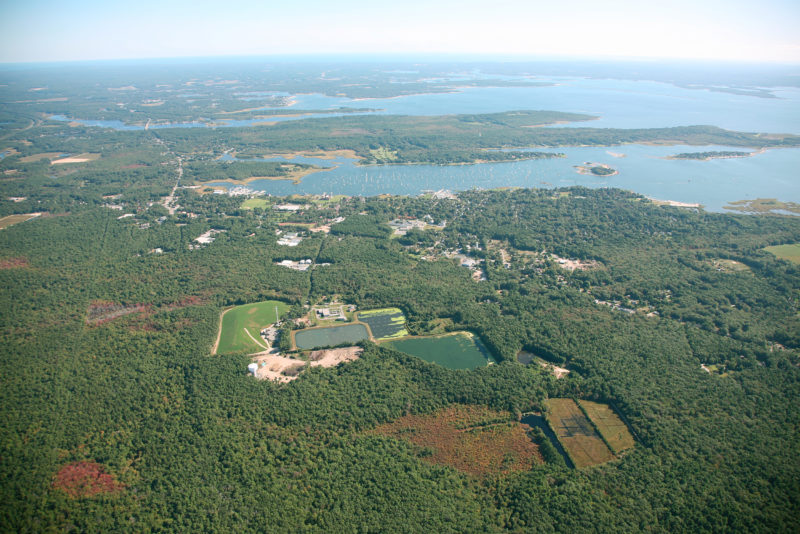Marion sewage lagoons to be cleaned up (finally!)
Persistent advocacy by the Buzzards Bay Coalition has yielded a resolution for a chronic source of nitrogen pollution to the Bay. First in Town Hall, then with state and federal agencies, and finally in court, the Coalition employed a range of science and advocacy tools to end a now 49-year-old sewage leak.

An aerial view of the leaking sewage lagoons at the Marion wastewater treatment plant (center) and nearby Sippican Harbor.
Marion is unique among Buzzards Bay communities in the way it has managed wastewater for nearly five decades. The town utilizes three unlined lagoons (totaling 20 acres in area) to hold sewage prior to treating it in the wastewater treatment plant. These lagoons are shallow pits in the ground that allow waste to leach contaminants, including nitrogen, into the groundwater below — and eventually out to Sippican Harbor, the Sippican River and Aucoot Cove.
In 2010, the Coalition conducted a study of the lagoons in cooperation with the Town that confirmed the lagoons were unlined, and were contaminating the underlying groundwater. This nitrogen-enriched groundwater flows to the nearest coastal waterway, contributing to declining health throughout Marion’s coastal waters.
Frustrated by Town Hall’s resistance to addressing the problem, the Coalition called on federal and state agencies for a solution. In 2017, the US Environmental Protection Agency (EPA) issued a permit which, if implemented, would have fixed the lagoons. It required that the town install an impermeable liner that prevents leaking. However, the town appealed that permit, and a resulting settlement agreement between the town and EPA still left 15 acres of lagoons unlined and leaking.
The Coalition redirected its efforts to the state Department of Environmental Protection (DEP) for a solution to solve the pollution leaking from the remaining lagoons. After many months passed without a resolution, the Coalition finally turned to the courts for help. In January 2018, the Coalition filed a complaint in State Court, urging the court to tell the town to bring the lagoons into compliance with state law.
Due to this multi-pronged science and advocacy effort, the town and MassDEP finally brokered a settlement that ends nitrogen pollution from these lagoons. Marion agreed to discontinue the discharge from the lagoons by lining the primary lagoon, maintaining the second lagoon as a dry basin (only to be used in emergencies), and abandoning the use of the third and largest lagoon.
This agreement accomplishes the goals the Coalition sought to achieve back in 2010, after the initial discovery of these leaking lagoons. With a solid solution now in hand, the Coalition dismissed its lawsuit against the town, but preserved the right to return to court should the agreement change.
With this issue now squarely in the rearview, the Coalition is excited to work with the town on long-term, sustainable solutions to its wastewater infrastructure needs. One such opportunity is evaluating Marion’s ability to join communities collaborating on regional solutions for sewer treatment in upper Buzzards Bay.
For years, the towns of Wareham, Bourne, and Plymouth, together with the Massachusetts Maritime Academy, have been moving together toward creating a shared, regional upper Bay wastewater treatment plant. Having Marion join this collaboration could be a historic victory for Bay protection. Not only would the Town’s sewage get the highest quality of treatment, but the Town’s existing plant, its discharge into Aucoot Cove, and the leaking lagoons could all be shut down — eliminating all municipal sewage discharge into Marion’s coastal waters.